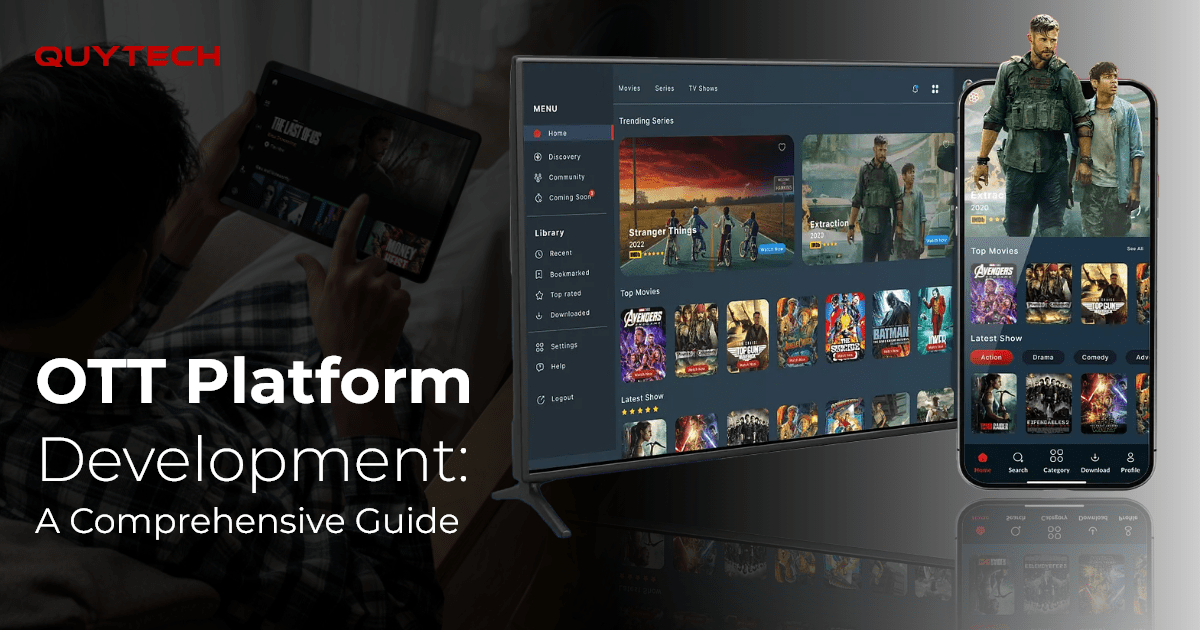The popularity of OTT platforms worldwide has revolutionized the delivery of live events, music, movies, videos, podcasts, and other content. OTT platforms, such as Netflix, Amazon Prime, Disney+, Hulu, Apple TV+, and others, gained immense popularity during the pandemic, and their market size and user base have been growing multifold since then.
Increased internet penetration, a shift in consumer preferences (from TV to OTT apps or on-demand content delivery platforms), increasing mobile phone users, and content availability and variety are some driving factors that have made these platforms capture users’ attention and hold a permanent place in mobile phones and smart TVs.
Considering their increasing demand and growing market size, businesses worldwide are investing heavily in OTT platform development or OTT app development. If you, too, are interested in the same and looking for a detailed guide to OTT platform development, you are in the right place.
This OTT app development guide thoroughly explains the market statistics, benefits/reasons why you should build an OTT platform in 2025, the stepwise process to OTT platform development, and a lot more. Let’s begin!
What is OTT?
In simple words, Over-the-top or OTT is about delivering audio and video content using the internet. To access this content, users don’t need to subscribe to a traditional cable or satellite television service. All they need is to download the OTT application or visit the OTT platform with a strong or uninterrupted internet connection.
Types of OTT Services
Before building an OTT platform, you should have an idea of its different types. Here they are:
Subscription Video on Demand (SVOD)
This particular type of over-the-top service focuses on providing users with seamless access to content. Users need to pay a monthly or yearly subscription fee for the same. The two most popular examples of SVOD are Netflix and Amazon Prime Video.
Transactional Video on Demand (TVOD)
This type of OTT model gives users the flexibility of paying for the particular piece of content they want to watch or access. In other words, you can call it a “per view” model. The two famous examples of TVOD include iTunes and Google Play Music.
Advertising-Based Video on Demand (AVOD)
In the AVOD OTT service, users can access content available on the platform for free. In-app or platform advertising is the prime source of revenue. The two popular examples of this type of OTT service are YouTube and Crackle.
Apart from the aforementioned ones, there could be a hybrid OTT platform that uses a combination of the above models to amplify revenue. There is also a Live Streaming OTT service where users can stream live news, sports, or other events. Audio OTT is another type of OTT service dedicated primarily to offering music and accessing content like podcasts.
These types of OTT services can also be considered while choosing the right monetization strategy for your OTT platform. Along with this, you can also consider affiliate marketing, niche monetization, and content syndication as your OTT platform monetization strategy.
OTT Platform Development: Market Statistics
Before you read about the step-by-step process of OTT app development, let’s take a look at some interesting statistics:
- The market size for Over-the-top services is expected to reach US$ 229.97 billion by 2032. This number was US$70.08 billion in 2024. This shows the immense potential this market holds.
- The OTT video market revenue is projected to reach US$ $343.82 billion in 2025.
- The number of users within the OTT video market is projected to reach 4.9 billion by 2029, with average revenue per user (ARPU) anticipated to be US$83.28 in 2025.
Step-by-Step Process to OTT Platform Development
Now that you know enough about over-the-top platforms, let’s move on to the most important topic of this blog, i.e., the step-by-step OTT platform development process or how to make your own OTT platform:
Step 1: Conduct a Thorough Market Research
The first step is to define your target audience and content focus, i.e., whether you want to build an OTT app for movies, TV shows, educational content, live events streaming, or any other. Also, conduct a thorough market analysis to find your competitors’ offerings and identify users’ expectations and preferences.
Don’t forget to decide on monetization strategies, the source of generating revenue. You may choose from subscriptions, advertising, transactional, and other strategies.
Step 2: Define Project Scope
Now, prepare a list of the features and unique selling points (USPs) your OTT app will have. Apart from this, also pay attention to choosing an optimal tech stack required to build an OTT platform.
Design wireframes and an MVP first to get an idea of the final look, appeal, and functionality of the over-the-top platform. Consider the legal and compliance requirements that you need to adhere to.
Step 3: Backend and Frontend Development
The next step is to build the server-side infrastructure and user interface of the OTT platform for multiple devices. Implementing robust video encoding pipelines and selecting a CDN is also a crucial part of this step. Apart from this, create APIs to ensure seamless integration of your OTT with other service providers, such as payment gateways.
Step 4: CMS Integration
The next step is to select or create a content management system that can handle large volumes of content and offers seamless content uploading, scheduling, and management. It is crucial for the smooth running of your OTT platform.
Step 5: Testing and Quality Assurance
Testing is crucial to ensure your OTT platform performs as expected and has all the features that have been defined during the project’s scope. Therefore, run functional, performance, security, and UAT testing on the developed OTT application.
Step 6: Launch and Maintenance
Deploy the developed over-the-top mobile application or platform on a reliable and scalable server infrastructure. Besides, submit OTT mobile and smart TV apps on the dedicated platform or store.
Step 7: Post-Launch Maintenance and Optimization
Regularly monitor the performance of your OTT platform to identify areas for improvement and update it with new features to enhance user experience and keep them engaged. Also, analyze user data and platform performance to optimize strategies for your OTT app’s growth and continued success.

Why Investing in OTT Platform Development is the Right Choice in 2025
With billions of users already using OTT platforms like Netflix, Hulu, Apple TV+, and others, it is evident that the market is quite promising. By investing in OTT platform development, you can become a part of this billion-dollar industry and generate substantial revenue.
#1 Increasing Demand for Online Content Streaming
Rising demand for content streaming globally clearly depicts that consumers’ preferences towards content consumption have changed. They are more inclined towards on-demand entertainment that can be accessed from anywhere.
#2 The Growing Need for Delivering Personalized Content and User Experiences
With AI entering every aspect of our lives, the demand for personalized content delivery has increased tremendously. OTT platforms, backed by top technologies like AI, ML, and more, can understand users’ preferences and interests to display them personalized content recommendations and improve engagement. In 2025 and beyond, this demand will only increase. While it is quite difficult for traditional broadcast televisions to meet this expectation, OTT platforms has the capability to tailor experiences.
#3 Direct Monetization and Data Control
OTT platforms enable a business to connect with its customers directly. They can have better control of the monetization strategies to generate more revenue. By building an OTT platform or application, you can own the data that can be further used for content creation, strategic decision making, and better marketing.
#4 The Opportunity to Expand to Niche Markets
The OTT industry or market is not limited to movies and music, businesses can expand to niche markets such as developing an OTT app for educational content or specialized sports. By building a dedicated OTT app or OTT video platform, businesses can capture a dedicated segment of the OTT market.
#5 Global Reach and Accessibility
OTT platforms are globally popular and in high demand. By creating such a platform, businesses can reach a global audience. The more the user base is, the higher the revenue will be. The global reach and accessibility are one of the reasons why you should develop an OTT platform.
Technology Stack for Successful OTT App Development
The technology stack for building an OTT platform for the education industry would be different than building one for the entertainment industry. However, the most common technology stack that any experienced OTT platform development company would choose is:
| Mobile | Flutter | Xamarin | Swift | Kotlin |
| Frontend | Angular | Vuejs | Metorjs | Expressjs |
| Backend | .Net | Java | Python | Go |
| Cloud Servers | Microsoft Azure | Google Cloud Platform | Amazon Web Services |
Advanced Features You Can Integrate to Make Your OTT Platform Stand Apart
Anyone with a strong technical background and development experience can build an OTT platform. However, building a successful OTT platform that immediately grabs users’ attention and becomes a hit requires equipping advanced features. Here are some features you need to consider:
- Watchlist: With this feature, users can save movies, TV shows, and other content to watch later. They can create a personalized queue and keep track of interesting content they might choose to watch later.
- Multiple Content Categorization: The feature will allow users to categorize their content based on various themes, moods, directors, language, and others. It will enhance content discoverability and user experience.
- Audience Analytics: With this feature, the user would be able to collect and analyze user data to understand their behavior, viewing patterns, interests, and demographics for building better marketing and content strategies.
- Personalized Content Recommendations: Adding this feature would require AI integrations. The AI-powered OTT platform will utilize strict algorithms and user data to show personalized recommendations for improved engagement and overall experience.
- Multiple Profile Creation: With this feature, users would be able to create separate profiles. For instance, they can create a kids’ profile, a dedicated profile for an adult family member to allow them to save content they like, get tailored recommendations, and more.
- Offline Playback: The “download for later” or “offline playback” feature will enable users to download the content to watch it without requiring internet. This can be really helpful for users with limited internet connectivity or the ones who want to view content while travelling or where there is no internet connection.
- Generative AI-Powered Search: The integration of generative AI into an OTT platform would allow users to search the content seamlessly. For example, they can give a text query “suggest some movies about some sports person’s documentary about how he succeeded in life”. Gen AI would understand the intent of the query and show accurate and relevant information.
Explore More: Generative AI in the OTT Industry: How It Will Impact the OTT Revolution
- Watch and Earn: This feature is quite an interesting one for users. With it, they would be able to earn rewards in the form of points, tokens, and other benefits. It would boost viewership while creating a gamified viewing experience and bringing users back to the OTT platform.
- 4K and HDR Support: Offer this feature to enable users to experience content in high-resolution and high dynamic range video quality. This would give them an exceptional viewing experience.
- Parental Control: With this feature, users would be able to set controls to restrict access to particular content for their kids and other users using their account. It would also enable them to create a safe viewing environment.
- 360-Degree View: Adding this feature to your OTT platform would allow users to watch a 360-degree view or explore a scene from different angles.
- Screen Casting: Provide this feature so that users can cast or mirror content from their mobile phones to television screens or other larger screens for an enhanced view and experience.
- Integration with Top Smart TV Platforms: Integrate this feature to make sure users can access your OTT platform from smart TVs, including Android TV, Apple TV, Roku, and Fire TV.
Apart from these, there are multiple features, like seamless subscription management, dynamic ad insertion, display mode, and others, that you can plan to integrate into your OTT platform.

Advanced Technologies That Can Pave a Path for Your OTT Platform’s Long-Term Success
Integrating exceptional features into an OTT platform is a definite contributor to an OTT platform’s success. However, one more thing that you can do is to back up your OTT app or platform with advanced technologies, such as AI, ML, blockchain, cloud computing, 5G, and more. Read on to know how:
AI/ML
Both artificial intelligence and machine learning work on data, i.e., collecting, storing, processing, and providing crucial insights. In OTT platform development, these technologies make the most of this data to offer personalized content recommendations, offer support services via chatbots and virtual assistants, optimize content based on various metrics, and detect fraudulent activities.
Blockchain
Blockchain’s immutable and decentralized nature can help you manage your content rights, facilitate microtransactions for content purchases and rentals, and enable tokenization for rewarding users with high engagement. Blockchain technology can also be used for decentralized content distribution and transparent royalty distribution to the content creators.
AR/VR
By integrating augmented reality and virtual reality into your OTT app development, you can ensure immersive viewing experiences, interactive content, and virtual social viewing. The better the customer experience, the higher the chances of your over-the-top platform’s long-term success.
You might also be interested in: How is VR One of the Best Technologies for the Media and Entertainment Industry?
5G
With 5G technology integration into your OTT platform development, you would be able to deliver high-quality streaming experiences for video content. The technology can also be used to optimize mobile viewing experiences and live streaming enhancements for high-quality broadcasts.
Read More: Role of 5G Technology in Mobile App Development: Everything You Need to Know About
Cloud Computing
Utilize cloud computing to ensure that your OTT application can be accessed from various devices and platforms. It would also assure you of the top-notch security and scalability of your over-the-top app.
Please note that the integration of these and other technologies totally depends on your specific project requirements.
How to Choose the Right OTT Platform Development Company
If you are someone who’s not looking for an answer to how to create an OTT platform for free or how to build an OTT platform, read this section thoroughly. With quite a number of companies claiming to be the best OTT platform development company, it is imperative that you know how to evaluate them to pick the one that is actually right for your project. Below are the tips that can help:
- Look for an over-the-top app development company with prior experience in delivering OTT video, OTT educational, and other types of projects. For this, check their portfolio or case studies.
- Make sure they have experience in the particular niche for which you want to build an OTT app.
- Ensure their proficiency in top cloud services, streaming protocols, and DRM. Also, evaluate their expertise in cross-platform OTT app development.
- Check if they focus on customization and scalability.
- Review their client testimonials and reviews to get an idea of their work ethic and market reputation.
- Make sure they prioritize security and thoroughly understand the legal and compliance requirements associated with OTT development.
- Clearly check the plans and cost estimations with offerings/inclusions.
- Lastly, check for post-launch support and maintenance services that are imperative to ensure the long-term success of your OTT platform by updating it with the latest features and keeping bugs or glitches at bay.

OTT Platform Development: Future Trends
The OTT world is continuously evolving, and in 2025 and the upcoming years, we may witness the following trends:
- More focus on AI-driven personalization for improved experiences and dynamic content adjustments.
- Focus on enhancing interactivity and social viewing by equipping features such as live polls, synchronized viewing parties, and more.
- Increased adoption of technologies such as AR, VR, and the Metaverse to create and deliver immersive experiences and enable users to watch content in a lifelike environment.
- Rise in implementation of blockchain for secure content distribution and ownership verification, tokenizing assets, and improved fan engagement.
- In the upcoming years, we may also see an increase in the integration of edge computing and 5G technologies into OTT platforms. The former will help to deliver ultra-low latency and high-bandwidth streaming, whereas the latter will support high-resolution video content.
Conclusion
OTT platforms have become a part of almost every internet user’s life. Platforms like Netflix, Amazon Prime Video, Apple TV+, and others offer the convenience of watching content, live sports, streaming music, and other events in an interactive way. Considering the worldwide popularity of OTT platforms, if you have also planned to build one, then this blog is what you need.
It is a comprehensive guide to OTT platform development that covers almost everything, from OTT platform development benefits/reasons to build one, market statistics, technology stack to be used, emerging tech integrations, advanced features for its long-term success, step-by-step process, future trends, and tips for choosing the right partner.




















Discussion about this post